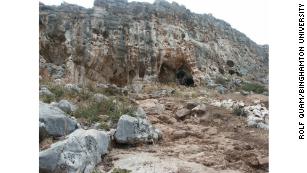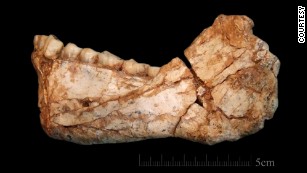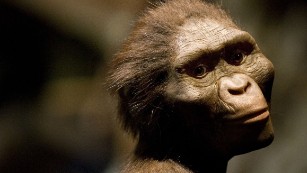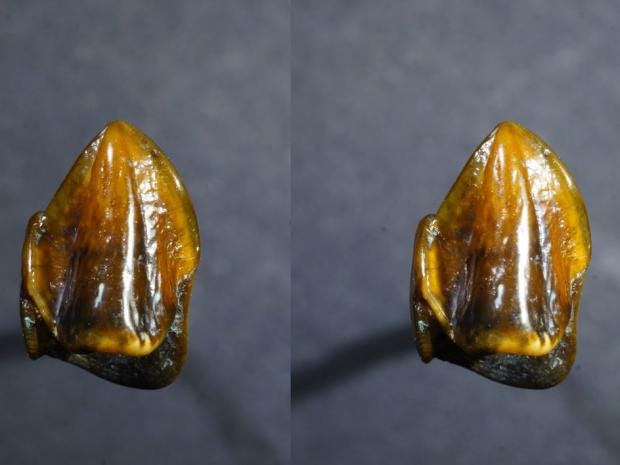Modern fossil discovery rewrites human history
Five amazing finds from the ancient world 01:11
Story highlights
- The oldest modern human fossil outside of Africa was found in Israel
- The findings suggests that modern humans migrated from Africa earlier than thought
(CNN)Scientists
have discovered the oldest known modern human fossil outside of Africa,
estimated to be between 177,000 and 194,000 years old, according to a new study
in the journal Science. The fossil of an upper jawbone that included
several teeth was found in a prehistoric cave site, Misliya Cave, in
Israel. Stone tools were also recovered at the site.
This
suggests that modern humans may have been on the move, specifically
migrating from Africa, at least 50,000 years earlier than previously
believed. It helps to explain previous findings of modern human fossils
in other parts of the world, which have been dated 90,000 to 120,000
years ago.
This rewrites the timeline of what we know about how Homo sapiens spread.
"We
now have clear fossil evidence that modern humans moved out of Africa
earlier than we previously believed," Rolf Quam, study coauthor and
anthropology professor at Binghamton University, said in an email.
"There have been previous suggestions of a possible earlier migration,
relying on both archaeological sites and ancient DNA studies, but now we
have an actual human fossil that proves it."
Three
different dating techniques were used to confirm the fossil's age and
classify it as Homo sapien, rather than Neanderthal or some other early
human ancestor.
The features of the jaw and teeth are unmistakably human, the researchers said.





















Stone
tools recovered at the site further confirm the age and technology
being used by these modern humans. They were shaped in a unique way
called the Levallois technique, where stones were flaked around the
edges to achieve a sophisticated point used in hunting. The discovery of
the tools along with the fossil in this location is the earliest known
association between the two in the region.
Finding
the tools and fossil in such close proximity also suggests that Homo
sapiens introduced this technology to the area when they appeared.
"The
rich archaeological evidence reveals that the inhabitants of Misliya
cave were capable hunters of large game species such as aurochs (extinct
large cows), Persian fallow deer and gazelles," Israel Hershkovitz,
study author and professor in the department of anatomy and anthropology
at Tel Aviv University, said in an email. "They controlled the
production of fire in hearths, made a wide use of plants and produced an
Early Middle Paleolithic stone tool kit, employing sophisticated
innovative techniques, similar to those found with the earliest modern
humans in Africa."
Detailed studies
of the tools are underway. Not only were they used for hunting, but
also the processing of animal skins, scraping and cutting plants,
scraping minerals and digging of edible tubers, Hershkovitz said.
Changing 'our perception of modern human evolution'
Researchers have many takeaways from these discoveries.
The
location of the fossil supports the idea that modern humans migrated
from Africa using a northern route through the Nile valley and the
eastern Mediterranean coast. It helps to explain why a modern human
fossil was found in China, dated to 120,000 years ago. It supports the
growing research that modern humans left Africa 220,000 years ago and
interacted with Neanderthals earlier than thought. And it suggests that
other early modern human fossils recovered in the Qafzeh and Es Skhul
caves in Israel are a result of the interactions between the Misliya
people and the other local populations of the region, Hershkovitz said.
"We
have a very long biological history, much longer than previously
thought," Hershkovitz said. "We evolved through interaction with other
hominin groups. We came out of Africa as early as 250,000 years (ago).
The Qafzeh/Skhul hominins are not the earliest modern human outside
Africa as previously thought. Actually, they were not migrants at all,
but rather descendants of the Misliya people."
The
discovery of modern humans outside of Africa earlier than expected has
implications concerning evolution. This means there were even earlier
opportunities for cultural and/or biological interactions with other
local non-modern human species, Quam said.
"Misliya
really changes our perception of modern human evolution," Gerhard
Weber, study coauthor and professor in the department of anthropology at
the University of Vienna, said in an email. "This evolution seems to be
not that straightforward or simple as we had it in the textbooks the
past years. Misliya is very modern. This wouldn't be surprising if it
were 10,000 years or 40,000 years, but it is around 180-190,000 years
old."
Earlier discoveries
In 2017, the discovery of the oldest Homo sapiens fossil
in Jebel Irhoud, Morocco, was announced. It dated back to 300,000 years
ago, 100,000 years older than previously discovered fossils of Homo
sapiens that had been securely dated. It also widened the "cradle of
mankind" to include all of Africa, since previous findings had only
occurred in east and south Africa.
But
the Jebel Irhoud fossil was most likely not as "modern" as the Misliya
fossil. The Jebel Irhoud fossil captures a moment in time of evolution.
The facial features of the skull look like a modern human, but the brain
case is very elongated and archaically characteristic of early humans.
There
has been increasing evidence that the modern human lineage diverged
from Neanderthals and Denisovans 500,000 years ago, making us close
relatives rather than direct descendants. Before the Jebel Irhoud
discovery, it was believed that the early modern humans we evolved from
were in Africa 200,000 years ago and looked very similar to modern
humans. But what happened in between that time?
This
is still unknown, although the researchers suggest the possibility that
there were multiple groups of hominins, or human ancestors, overlapping
and having complex relationships.
Because
they didn't previously have fossil evidence of Homo sapiens from
300,000 years ago, this helps to fill a small part of that gap in the
fossil record. The fossils provide insight about this evolutionary time
for Homo sapiens before the early modern stage 200,000 years ago.
'A big step forward'
The Misliya discovery adds to the research that scientists hope will eventually solve the mystery of the in between time.
"Misliya
tells us that modern humans might have been in touch with other
populations, including archaic ones that were already in Eurasia," Weber
said. "Now it is conceivable that also other modern humans, even a bit
older than Misliya, might have left Africa -- I wouldn't be surprised
now if someone finds a modern human in Eurasia at a time of 220,000
years -- and encountered Neanderthals or some forms on the way to
Neanderthals.
"As any good science,
Misliya raises new questions, but we made a big step forward, away from
a too simple picture," Weber concluded.
The researchers are continuing their study of the fires from the Misliya cave, as well as the stone tools.
"We
have started excavating at two sites that were excavated in the past,
the Skhul and Tabun caves, with the hope to find some hominins that will
allow us to answer further questions relating to the late phase of
human evolution," Hershkovitz said.




































 NOVOSIBIRSK, RUSSIA—According to a report in
NOVOSIBIRSK, RUSSIA—According to a report in 